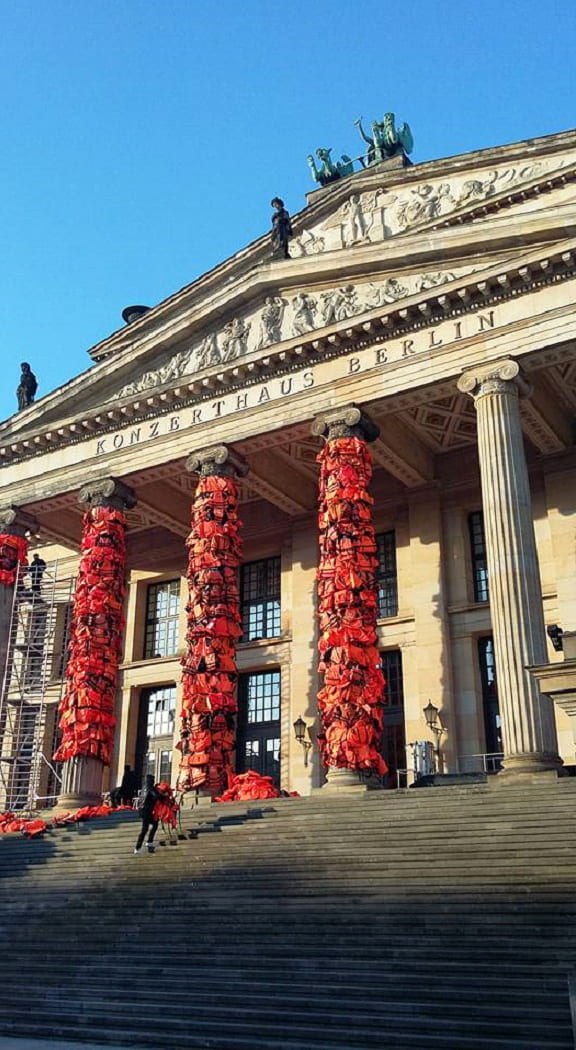The world famous Berlin International Film Festival, called the Berlinale, is a signature event that elegantly colors the dark, cold winter in Berlin.
Film fans arriving at Berlin from all over the world to experience this special atmosphere, and they go to cinemas or see the Red Carpet. During this period, the number of tourist increases, and related promotions and venues are set up, leading to a ten-day period for Berlin residents in which the town is bustling in a festive mood. This year’s Berlinale, which marked its 66th anniversary, sold a total of 337,000 tickets – a record-high number in participants.
 Red Carpet venue
Red Carpet venueAttracting the most attention are the films participating in the competition, but that isn’t all. There are also various categories in which retrospective films as well as “mini-cinema” films are screened. I always look forward to the showing of these programs each year, but because there are so many interesting films, it’s difficult to see all the films I want to see.
 Ticket booth in a shopping center at the Potsdamer Platz
Ticket booth in a shopping center at the Potsdamer PlatzAlthough the Berlinale bestows prestigious film awards, its tickets are not overly expensive and does not feel inaccessible. Since 2010, there has been a project called the “Berlinale goes Kiez“, which means “Berlinale goes to street corners”. Titled the Flying Red Carpet, it’s developed so that films from the festival can be seen at small neighborhood cinemas in street corners. These kinds of creative projects help to connect the event and its hosting town.
 Full screening program of the Berlinale
Full screening program of the BerlinaleThe Berlinale is considered a very political film festival as it often praises films with social themes. The Golden Bear, which is the highest prize, was awarded to a documentary film titled Fucoammare featuring the refugee crisis.It portrays not only the challenges faced by refugees but also the life of island residents on Lampedusa, an island in the Mediterranean famous for the many refugee-carrying boats that drift ashore there. Recently in Europe, a day doesn’t pass by when you don’t hear about the refugee issue. However, the residents of the island are personally facing this issue, unlike us whose lives aren’t directly affected despite all the discussions we hear on the news. The film gave an impact with its matter-of-fact manner in which the state of the island was shown, where an emergency situation has turned into the norm. It was as if you were watching a microcosm of Europe in a small island, with people struggled to arrive at the island, people helping the refugees and those who simply carry on with their own lives.It came as a surprise that a documentary won the Golden Bear award, but the lack of a solution in the film is a realistic depiction of the latest perplexity around this issue in Europe.
 Setting up the art installation
Setting up the art installationChinese artist living in Berlin Ai Weiwei, serving as the Jury President for the Cinema for Peace, which is a film festival for peace held in conjunction with the Berlin International Film Festival, designed an art installation using life vests as an expression of the refugee drowning deaths in the Mediterranean. This installation involved attaching the refugees’ life vests that were actually left on the shore to the columns of the Konzerthaus in Gendarmenmarkt square. It appeals strongly to those who visit the building.
 The life vests used for the installation were ones that had actually been used and drifted ashore
The life vests used for the installation were ones that had actually been used and drifted ashoreAi Weiwei himself is producing a documentary film on the refugee issue, and so he has been interviewing refugees living at the Tempelhof Airport which is currently not in use.International film festivals all offer their own characteristics including political colors, but this year’s Berlinale can especially be considered a part of a temporary social phenomenon.Perhaps focusing on these themes is a necessary compromise in order to enjoy this glamorous film festival while knowing that there are refugees risking their lives to come to Germany even in this season with stormy seas.One thing, however, is that I can’t help but feel something is out of place, when I see those in the film industry wearing expensive clothing and accessories also put on the same heating pads that are distributed to the rescued refugees.


































































